Lake Sidney Lanier Near Buford Reservoir Report
Last Updated: January 2, 2026
Lake Sidney Lanier is a reservoir located in Buford, Georgia created in 1956 by the U.S.
°F
°F
mph
Wind
%
Humidity
Summary
Army Corps of Engineers. The lake's primary purpose is to provide hydroelectricity, flood control, and water supply. The lake is also used for recreational purposes, such as boating, fishing, and swimming.
The hydrology of Lake Sidney Lanier is primarily fed by the Chattahoochee River, Chestatee River, and numerous smaller creeks. The lake has a surface area of over 38,000 acres and a maximum depth of 160 feet. The lake's water levels are closely monitored and managed by the Corps of Engineers to ensure proper water supply and flood control.
The lake also serves as a primary water source for the city of Atlanta and the surrounding communities. The surrounding areas of the lake are also used for agricultural purposes, including cattle farming and row crops. In addition, the lake and surrounding areas are home to a variety of wildlife, including deer, beavers, and numerous bird species.
Reservoir Details
| Elevation Of Reservoir Water Surface Above Datum, Ft 24hr Change | 0.01% |
| Percent of Normal | 100% |
| Minimum |
1,050.81 ft
2007-12-28 |
| Maximum |
1,076.71 ft
2020-02-21 |
| Average | 1,066 ft |
| Hydraulic_Height | 193 |
| Drainage_Area | 1040 |
| Year_Completed | 1958 |
| Nid_Storage | 2554000 |
| Structural_Height | 231 |
| Primary_Dam_Type | Earth |
| River_Or_Stream | CHATTAHOOCHEE RIVER |
| Foundations | Rock |
| Surface_Area | 47182 |
| Hazard_Potential | High |
| Outlet_Gates | Slide (sluice gate) - 2, Valve - 0 |
| Dam_Length | 2470 |
| Nid_Height | 231 |
Seasonal Comparison
Temperature, Air, °C Levels
Barometric Pressure, Mmhg Levels
Wind Speed, Mph Levels
Wind Direction, Degrees Clockwise From North Levels
Precipitation, Total, In Levels
Relative Humidity, Percent Levels
Elevation Of Reservoir Water Surface Above Datum, Ft Levels
Reservoir Storage, Thousand Acre Feet Levels
Weather Forecast
Nearby Streamflow Levels
Dam Data Reference
Condition Assessment
SatisfactoryNo existing or potential dam safety deficiencies are recognized. Acceptable performance is expected under all loading conditions (static, hydrologic, seismic) in accordance with the minimum applicable state or federal regulatory criteria or tolerable risk guidelines.
Fair
No existing dam safety deficiencies are recognized for normal operating conditions. Rare or extreme hydrologic and/or seismic events may result in a dam safety deficiency. Risk may be in the range to take further action. Note: Rare or extreme event is defined by the regulatory agency based on their minimum
Poor A dam safety deficiency is recognized for normal operating conditions which may realistically occur. Remedial action is necessary. POOR may also be used when uncertainties exist as to critical analysis parameters which identify a potential dam safety deficiency. Investigations and studies are necessary.
Unsatisfactory
A dam safety deficiency is recognized that requires immediate or emergency remedial action for problem resolution.
Not Rated
The dam has not been inspected, is not under state or federal jurisdiction, or has been inspected but, for whatever reason, has not been rated.
Not Available
Dams for which the condition assessment is restricted to approved government users.
Hazard Potential Classification
HighDams assigned the high hazard potential classification are those where failure or mis-operation will probably cause loss of human life.
Significant
Dams assigned the significant hazard potential classification are those dams where failure or mis-operation results in no probable loss of human life but can cause economic loss, environment damage, disruption of lifeline facilities, or impact other concerns. Significant hazard potential classification dams are often located in predominantly rural or agricultural areas but could be in areas with population and significant infrastructure.
Low
Dams assigned the low hazard potential classification are those where failure or mis-operation results in no probable loss of human life and low economic and/or environmental losses. Losses are principally limited to the owner's property.
Undetermined
Dams for which a downstream hazard potential has not been designated or is not provided.
Not Available
Dams for which the downstream hazard potential is restricted to approved government users.
Area Campgrounds
| Location | Reservations | Toilets |
|---|---|---|
 Sawnee
Sawnee
|
||
 Shoal Creek - Lake Lanier
Shoal Creek - Lake Lanier
|
||
 Bald Ridge Creek
Bald Ridge Creek
|
||
 Shady Grove - Lake Lanier
Shady Grove - Lake Lanier
|
||
 Chestnut Ridge - Lake Lanier
Chestnut Ridge - Lake Lanier
|
||
 Charleston - Lake Lanier
Charleston - Lake Lanier
|

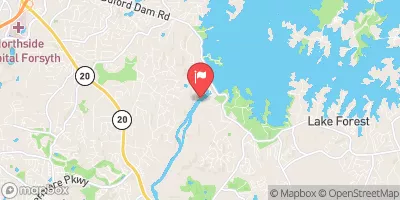
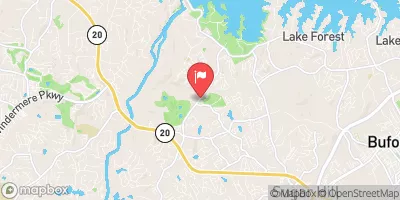
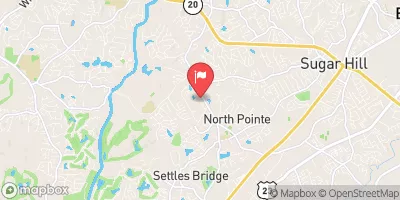
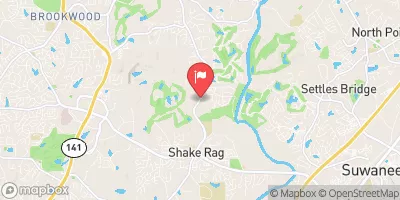
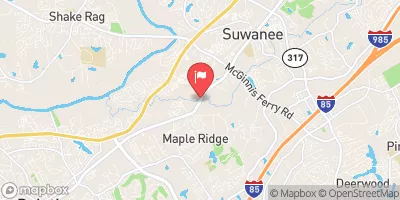
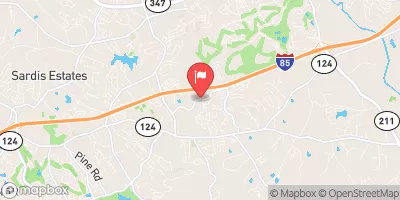
 Buford Dam
Buford Dam
 Lake Sidney Lanier Near Buford
Lake Sidney Lanier Near Buford
 Kings Point Drive Forsyth County
Kings Point Drive Forsyth County